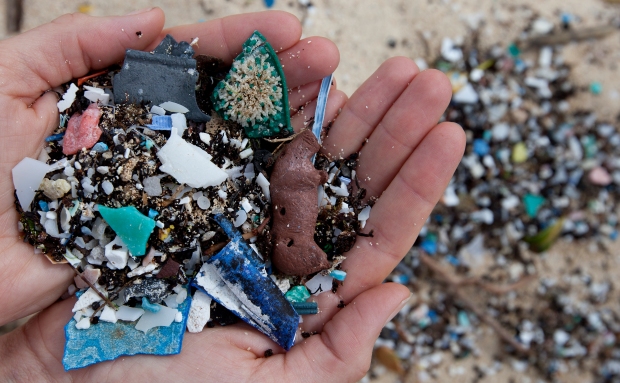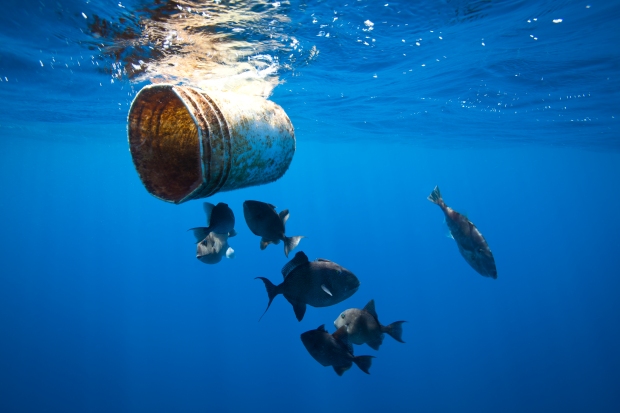a plastic ocean


Plastic is a seemingly innocuous substance that has woven it’s way across the globe and into every phase of our lives. From birth onward, we depend on plastic as a vehicle or component for a variety of products – baby bottles, polyester apparel, food packaging, canned goods, lotions, chewing gum, facial scrubs, and the list appears to be nauseatingly endless. So if plastics are a part of daily life, it can’t be bad for us or the planet, can it? I’m going to assume it comes as little surprise that the effects of plastic are becoming a serious concern, and the findings aren’t looking good. I want to articulate here that plastic has a place in the world for an array of arguably crucial products that save lives. Plastics used for medical devices, bullet proof vests, computers and technical products have a value that is hard to strip away from the utility of the finished product.
But that doesn’t mean that all plastic is necessary. Take for example, the plastic straws at any given coffee shop. The plastic straw gets used once, for less than a minute, is discarded, and then begins the long process of disposal and slow degradation. And by slow, I mean possibly, never. Even when they photo-degrade in landfills or in the ocean, the plastic particles never go away completely. The United Nations Environment Programme estimates that there are 46,000 pieces of plastic litter floating in every square mile of the ocean’s surface. During our time in the Sargasso Sea, we saw every coast line littered with micro-plastics and large amounts of free floating plastic in the ocean. On some mornings, you could watch the plastic crash ashore with the rising tide and collect in rows along the beach.


When you can scoop up more plastic than actual biomass from the ocean, it’s clear there is a relevant problem. Currently, there is a garbage patch in every major ocean across the globe, which totals to five large plastic gyres, and six additional smaller ones. They continue to grow as we produced millions of tons of disposable plastic product each year. The plastic products slowly break down in our oceans from wave action, sun and wind degradation. The now smaller fragments are mistakenly consumed for food by birds and fish. The micro-plastics collect inside the digestive tract of the marine life, causing starvation, dehydration, and often times death. When the belly is full of plastic, the fish isn’t hungry because of the false feeling of being full. If it does eat, there are problems with vital nutrient absorption and excretion. It is estimated that 267 marine species are known to have been entangled or severely suffered from ingesting plastic. The whole marine ecosystem gets affected, sea turtles, fish, sea birds, whales, coral reefs and other immobile living organisms.
Almost 1/2 of the plastic we use, we use just once, and then we throw it away. The problem is, there is no away. Every piece of plastic ever made is still in existence today. 100 million tons of plastic are manufactured every year for products that are used for less than 5 minutes. This is why shifting away from the modern convinces that plastic provides is a dynamic situation, with many layers stacking in from different sides of the equation. The convenience of the plastic straw has become a thoughtless part of our every day life, and we aren’t aware that the little straws will end up in our land fills, road sides, water ways and oceans. The Environmental Protection Agency tells us that only 9 percent of plastic bags are recycled in the US, and a mere 7% of ALL plastics end up being recycled. Often times, plastic can’t recycled into the same type of plastic. Once plastic is used as a water bottle, it can never be a plastic water bottle again. Products that are made from recycled plastic don’t stay recyclable because the product is a mixture of different types of plastic, which causes structural weakness in the resulting material, rendering it useless. So it comes as a little surprise that our oceans are becoming a plastic graveyard that’s growing every year.


Stay tuned for next week’s feature about how plastic is made, bio-degradable plastics, persistent organic pollutants, the threats of bio-accumulation as plastic toxins are entering the food chain, and how our small individual changes can make a big impact.






Thanks for bringing this issue to your blog. The fact that scientists seeing plastic start to make its way into the cells of fish and other marine life is alarming. Keep up the good work on this.-
http://searunner.wordpress.com
Reblogged this on Jess Renard.
… Interesting but depressing at the same time. I live in Indonesia and the amount of plastic they use here on a daily basis is incredible… liquids are provided in knotted plastic bags… packers at the supermarket put three or four items in one bag and move onto the next….bonfires of plastic carrier bags are regular sites on the roads…the Dutch-invented canal system is clogged with rubbish and the stench is horrific…in Bali the beaches have to be cleaned of great swathes of rubbish every day… i could go on. It is so incredibly sad that the environment has taken a back seat to our consumerism and that, despite huge amounts of coverage on global warming etc etc… people still think it’s someone else’s problem.
Reblogged this on Lucky Turtles and commented:
In Tunisia there is a massive trash problem, much of which could be alleviated by a strong recycling program.
How terrible … and it’s the same problem everywhere .. even out nice and normally clean beaches up here in the North. A powerful post and it’s only us that can make a difference to this. How I see it .. is it all down how we been taught as kids by our parents.
As someone who pretty much grew up on a sailboat and lived by the shore my whole life, I can safely say that this is not something to be taken lightly. And the sad part is that very few people seem to be informed about the dangers of this product. More than once I’ve seen birds tangled in plastic bags or bird nests made of plastic remains and it’s painful to witness.
Espicially in the states, which was something i noticed when i moved here for my year abroad. You can barely set a foot in a store without getting plastic bags thrown at you.
Buying some bananas? Here, have a couple of plastic bags in case the first one snaps. Something has to be done, and fast, and remember, you CAN make a change.
A powerful and sobering post.
Awesome Article! This project just keeps getting better and better!!!
I tried to approach several brand companies about their responsibility on plastic waste – sadly they wouldn’t comment or be prepared to do anything about it, one of these companies was GSK the other Johnson & Johnson. Having worked with Thames 21 on several clean ups it was ear buds and disposable pads and nappies plus Lucozade bottles and bottle tops. My quest continues to stop this level of waste entering our waterways and shoreline.
Reblogged this on asafitriku.
Thank you! Looking forward to re-blogging your site soon.
So Sad – makes me cringe a bit too! As an outdoors type I try and leave NO TRACE behind.
…A sad reality! …we need to raise awareness of this situation.